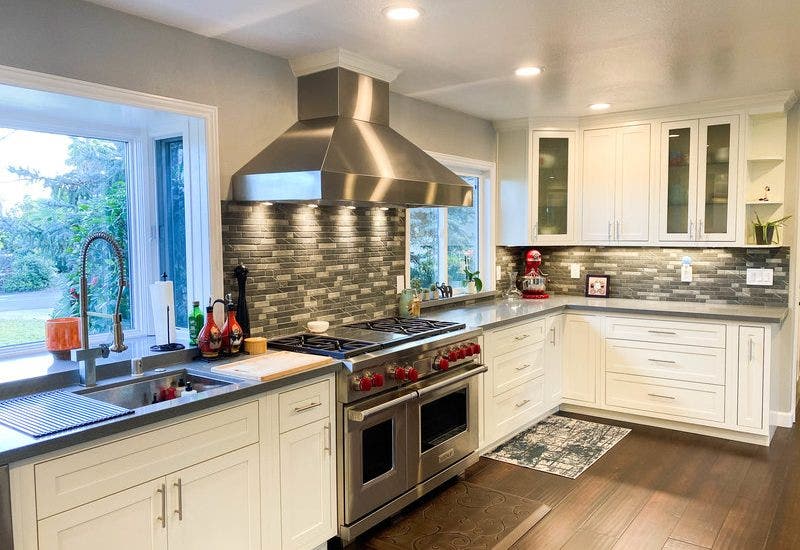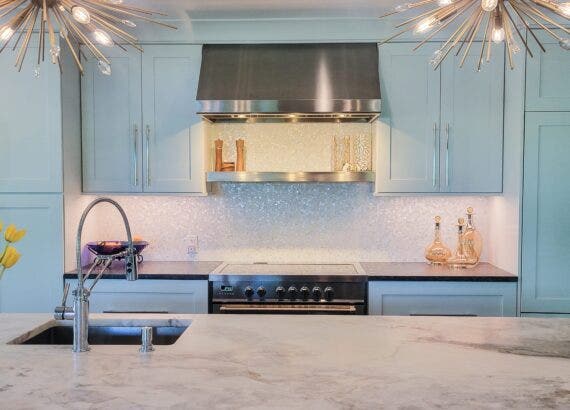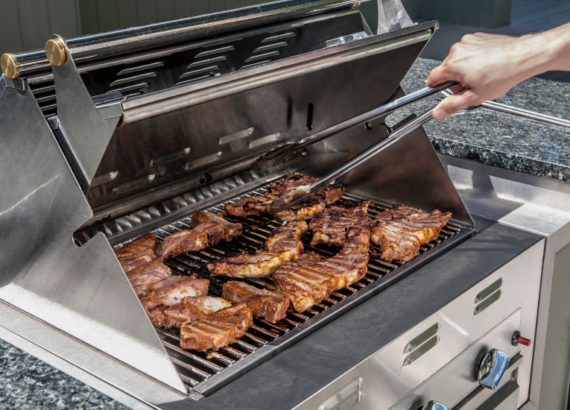Can a slide-in range be installed as a freestanding range?

Shopping for a range can be overwhelming. Slide in, freestanding, drop-in ranges…which do you choose?
Freestanding ranges are going out of style because they don’t look as modern as the other types. But they are much cheaper.
Still, the two most popular choices are slide-in or drop-in ranges. Some people wonder: can a slide-in range be installed as a freestanding range?
No. Slide-in ranges fit between kitchen counters and cabinetry, so they do not have finished sides. This won’t look good in your kitchen as a freestanding range.
A freestanding range stands alone. It typically has controls in the back of the range and knobs in the front. A freestanding range has finished sides, so you don’t need to install it between cabinets.
Slide-in ranges have controls and knobs in the front. They look more modern than freestanding ranges, but they are more expensive.
Depending on the manufacturer, some slide-in ranges will sit flush with your cabinets, while others will be a few inches deeper.
You want your range, not including the door, to be flush with your kitchen cabinets. If it’s not, you will need a counter strip in the back.
For example, if the depth of your counter is 38” and the depth of your range is 36” to the door, you’ll want a 2” counter strip.
Some ranges come with a stainless steel filler, so you won’t need a counter strip. For small gaps, check out silicone strips on Amazon. They won’t last as long as the countertop. But they are a quick, affordable solution.
Before you decide on a filler, check the owner’s manual. This is your best resource to start and finish a smooth installation.
Table of Contents
Can my range be flush to the back wall?
It can, but you should definitely check your owner’s manual. Some people may be concerned about the amount of heat the burners generate. Without a counter strip or silicone strip, the heat may damage your backsplash. If you don’t see anything about this in the manual, call the customer service team for some advice.
In most cases, you’ll need some sort of guard or counter strip between your range and the back wall. So, if in doubt, install one of those first. Some ranges come with a stainless steel piece that sits behind the range. These are a lot easier to install than a countertop strip.
The more powerful your range, the more British Thermal Units (BTUs) it will have. Large ranges have high BTUs too. This much heat will likely damage your back wall, so you’ll want a countertop strip for sure. But, again, take a look at the owner’s manual.
The countertop strips not only protect from heat, but also prevent water, food, and other debris from falling behind your range. Cleaning behind your range is a real hassle, so the strips are a real lifesaver.
Do I need a backsplash behind a slide-in range?
Backsplashes are not mandatory, but they are everywhere in today’s modern homes. The controls on a slide-in range are in the front, not on a lip in the back of the range. So, if you install a backsplash, make sure it extends all the way to the base of the countertop.
If you have a freestanding range with controls in the back, your backsplash won’t need to cover as much space.
Do slide-in ranges stick out?
Yes. Your slide-in range, not including the door, should be flush with the base cabinets. But the oven door typically sticks out a couple of inches, which protects the surrounding cabinetry from damage.
Depending on the manufacturer, some ovens stick out further than others. More than two inches is fine, but you don’t want to install an oven that won’t stick out that far. It could be a safety hazard.
Each range may be slightly different, so take a look at the owner’s manual to find the exact requirements of your range.
Why are freestanding ranges cheaper than slide-in?
Slide-in ranges offer a much more custom, built-in look. Between your countertops, they look much more sleek than a freestanding range. Most freestanding ranges have controls in the back, which is becoming increasingly outdated in today’s kitchens.
Is a slide-in range worth it?
Slide-in ranges are more expensive than freestanding ranges, but they may very well be worth it! If you are going to put a lot of time, effort, and money into a remodel, a slide-in range is the way to go. You wouldn’t want to spend thousands on countertops just to invest in a cheap range, right?
But if you’re not as serious about the project, a freestanding range will work just fine.
Hopefully we answered your questions about slide-in ranges thoroughly. Always defer to the owner’s manual if you’re in doubt. Or talk to a professional contractor before you make any quick decisions.
Professional ranges can be expensive, especially including installation. So you want to plan everything out correctly the first time. Good luck with your project!
Related Articles
Can I install an over-the-range microwave above a wall oven?
Can a slide-in range be installed as a freestanding range?
No. Slide-in ranges fit between kitchen counters and cabinetry, so they do not have finished sides. This won’t look good in your kitchen as a freestanding range.
Can my range be flush to the back wall?
It can, but you should definitely check your owner’s manual. Some people may be concerned about the amount of heat the burners generate. Without a counter strip or silicone strip, the heat may damage your backsplash. If you don’t see anything about this in the manual, call the customer service team for some advice.
In most cases, you’ll need some sort of guard or counter strip between your range and the back wall. So, if in doubt, install one of those first. Some ranges come with a stainless steel piece that sits behind the range. These are a lot easier to install than a countertop strip.
Do I need a backsplash behind a slide-in range?
Backsplashes are not mandatory, but they are everywhere in today’s modern homes. The controls on a slide-in range are in the front, not on a lip in the back of the range. So, if you install a backsplash, make sure it extends all the way to the base of the countertop.
If you have a freestanding range with controls in the back, your backsplash won’t need to cover as much space.
Do slide-in ranges stick out?
Yes. Your slide-in range, not including the door, should be flush with the base cabinets. But the oven door typically sticks out a couple of inches, which protects the surrounding cabinetry from damage.
Depending on the manufacturer, some ovens stick out further than others. More than two inches is fine, but you don’t want to install an oven that won’t stick out that far. It could be a safety hazard.
Each range may be slightly different, so take a look at the owner’s manual to find the exact requirements of your range.
Why are freestanding ranges cheaper than slide-in?
Slide-in ranges offer a much more custom, built-in look. Between your countertops, they look much more sleek than a freestanding range. Most freestanding ranges have controls in the back, which is becoming increasingly outdated in today’s kitchens.
Is a slide-in range worth it?
Slide-in ranges are more expensive than freestanding ranges, but they may very well be worth it! If you are going to put a lot of time, effort, and money into a remodel, a slide-in range is the way to go. You wouldn’t want to spend thousands on countertops just to invest in a cheap range, right?
But if you’re not as serious about the project, a freestanding range will work just fine.







Comments are closed.